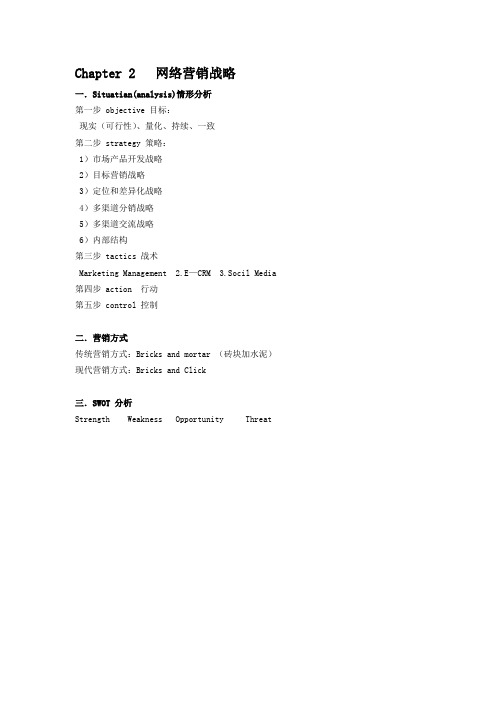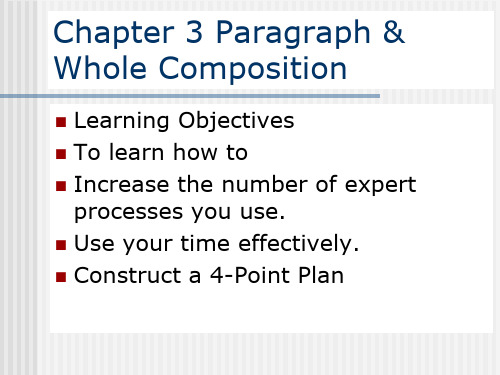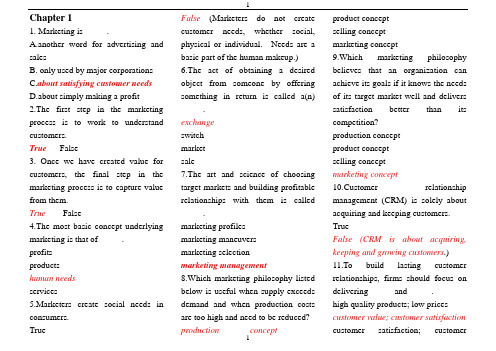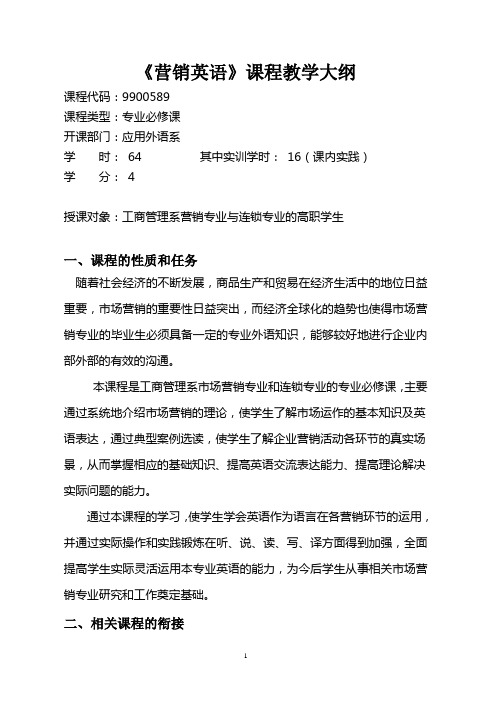Marketing Chapter 3
- 格式:pdf
- 大小:743.35 KB
- 文档页数:34


Chapter 2 网络营销战略一.Situatian(analysis)情形分析第一步 objective 目标:现实(可行性)、量化、持续、一致第二步 strategy 策略:1)市场产品开发战略2)目标营销战略3)定位和差异化战略4)多渠道分销战略5)多渠道交流战略6)内部结构第三步 tactics 战术Marketing Management 2.E—CRM 3.Socil Media 第四步 action 行动第五步 control 控制二.营销方式传统营销方式:Bricks and mortar (砖块加水泥)现代营销方式:Bricks and Click三.SWOT 分析Strength Weakness Opportunity ThreatChapter3 客户界面屏对屏需要界面一.界面考虑要素:1.场景:(1)美学——面向视觉效果(2)功能(3)美学+功能2.分类和频道:分类在纵坐标频道在横坐标3.颜色:a信息:A.以信息传递为主颜色简洁B.以娱乐为主,大胆夸张C.以销售为主,色调轻b文化:中国(红)阿拉伯(绿)c年龄:儿童鲜艳d性别:男(单一)女(多样)e阶层:粉色:温柔可爱浪漫甜蜜红色:激情力量温暖橙色:温暖积极活泼晚霞西方人眼中:低劣物美价廉蓝色:温馨平静遥远简单商务绿色:自然健康乐观安全鲜艳紫色:高雅黑色:邪恶严肃恐怖庄重白色:朴实纯洁4.内容:a提供物质组合:由企业提供产品服务信息b吸引力组合:1.认知吸引力(功能方面)2.情感吸引力(例七格格)c多媒体组合(音频/视频)视觉、听觉、味觉、嗅觉、触觉5.社区(社化媒体)6.定制:个性化定制、企业化定制7.沟通:公司与客户的双向对话单向式:规模邮件、FAQ 常见问题汇总交互式(双向)沟通:即时沟通、非即时沟通8.链接:不能连到竞争对手上9.商务:注册;购物车;安全;信用卡核准;配置技术;订单跟踪;交付选择(质量、速度);会员订单10.X图形(页面左上角)Chapter4 网络消费者行为营销环境:宏观营销环境:技术、自然环境、人口微观营销环境:竞争者、经销商、商家、大众第一节网民属性一.网民人口统计属性网民规模:1. 总体网民规模 2.性别结构 3.年龄结构 4. 学历结构 5.职业结构6.收入结构7.城乡结构二、网民技术统计属性1.家庭规模2.手机网民规模3.上网设备4.上网地点三、网民行为属性1.上网时长2.网络消费者属性第二节网络消费者属性一.网络消费者人口普及属性1. 用户规模2. 性别3. 年龄4. 属性二.网络消费者行为属性1. 产品属性2. 购物时间3. 网购频次4. 网络支付三.网络消费者的地理属性:地理差异第三节网络消费者决策的过程一.网络消费者类型direcied information-seeker信息体验undirecied information-seeker非直接信息体验directed buyers直接购买者bargen hunter价格猎手entertainment seekers娱乐体验二.网络消费者决策过程1.无意识的2.有意识的(社会建议)3.供应商的选择4.评估和选择 5 购买刺激实现 6.购后行为评估Chapter5 客户体验管理第一节用户体验设计体验经济:服务经济高级阶段基本特征:1.非生产性2.短周期性3.互动性4.烙印性5.经济价值的高附加性客户体验定义:指目标客户与公司交互过程中遇到的所有激励因素的感知与诠释客户体验管理:是战略性的管理客户对产品或公司全面体验的过程客户体验七要素:1.客观要素2.感知3.遭遇要素4.刺激反应要素(包括多重变量反映)5.感官要素6.认识和情感要素7.相对要素第二节客户体验的层次、阶段a.功能b.熟识:1.定制能力2.沟通3.一致性4.可信赖性5.从消费到休闲活动c.福音传播:1)把好消息扩散分享2)社区的积极分子3)体验的卫士七个致命的过失:没有搜索; Out of stock;没有联络信息;没有礼品选项没有运费信息;没有选项按钮;没有打印第三节客户体验优化、管理方法1)确定传递给目标客户的品牌承诺2)设置评分配置权重,触点配置3)分析与评估客户满意度4)流程分析与评估5)持续的监馈Chapter 6 网络品牌品牌解析:D差异性 R相关性 P认知价值隐性因素:文化属性艺术用户显性因素:型性名称符号色彩音乐故事网络品牌概念广义:通过互联网建立的品牌,对既有的通过互联网宣传的线下品牌;狭义品牌基于互联网建立及发展的品牌;例:七格格、凡客、亚马逊网络品牌构建中的地位1)网络混合型成分a. 宣传产品和服务b. 宣传网站,网站进一步宣传产品与服务2)个人信息的传递3)不断扩大的市场或技术空间4)强化品牌的信息5)加强互动网络品牌的特点1)基于网络2)灵活的价格策略(草根性)3)灵活的产品策略4)轻公司的运作网络品牌决策1)使用现有网络品牌2)在线移植离线品牌(线下品牌)3)创造网络新品牌:个性化简短富有含义易于拼写记忆4)协作品牌Chapter 7 网络营销渠道一.解中介化与再中介化二.网络营销服务商综合性的网络信息平台(阿里)网络信息平台——专业性的(中国化工网)门户网络营销平台(新浪)企业上网综合服务平台(万网——网站建设)专业性的网络营销产品——谷歌关键字、百度竞价位纯粹的网络营销服务商(亿码)三. 网络营销渠道网络营销渠道:商品或劳务由生产者向消费者转移的过程中经历的路径或通道网络营销:基于互联网的拼图,商品或服务向消费者转移的路径网络营销渠道的优势:1)可以继承制造商、中间商、经销商连接一起(集成性)2)交互性:体现在生产者与消费者的沟通上3)快捷服务4)渠道的经济性对比线上线下优势:线下优势:1.地理位置 2.规模优势,产品齐全3.经济优势4.专业优势:理解流通领域的进、销、存网络营销渠道功能:1)物流功能:顾客直接驱动、全面服务、可跟踪性2)支付功能3)融资功能:阿里金融4)信息功能网络营销渠道的分销策略:1)密集型分销(家居日常)2)排他性或奢侈性分销(高档品)3)选择性分销(家电)网络营销渠道冲突类型:1)网络营销渠道与传统营销渠道的冲突2)网络营销渠道的纵向冲突(分销商、生产者等)3)网络营销渠道的横向冲突网络营销渠道成员分类:1)网络营销渠道之辅助商(传统辅助商转型为新兴的网络营销辅助商)2)信息中介:中国的:商业性中介(派代网,艾瑞网);非商业中介(中国互联网信息中心、中国电子商务信息中心)国外的:商业性中介();非商业性的(pew)3)间接网络营销A.网络交易平台:B-B:阿里巴巴、环球B-C:淘宝、京东、卓越、当当淘宝商城:佣金、保证金、技术服务年费京东:保证金、产品销售、技术服务年费(自荐物流)卓越:零投入、佣金、保证金(自荐物流)当当:佣金、保证金、平台使用费B.网络批发商:1.独立 2. 依托于B2B网络批发商特点:交易量大,交易次数少C. 网络零售商4)网络营销直接渠道(戴尔、联想)Chapter 8 网络促销组合第一节网络广告1)网络广告形式的发展:1997年3月,中国第一则商业性的网络广告出现在Chinabyte网2)网络广告的优势1.覆盖范围广;2.信息容量大;3.交互性(互动性);4.实时可控性;5.针对性;6.便于跟踪,统计,评估;3)网络广告形式全屏性;横幅广告;按钮式广告;文字链广告;邮件广告;插入式广告、弹出式广告;游戏广告;对联式广告;悬浮式广告;富媒体广告;拖曳式广告;第二节销售促销:在线折价,打折;网页赠品、样品;网络抽奖、游戏竞赛;优惠劵第三节网络公关概念:网络公共关系,即企业通过网络平台开展公共关系活动,通过网络作为平台支持,开展关于品牌传播的信息发布、信息监控、舆论疏导、评估分析等工作,强化品牌的市场公关执行力量。



1 1Chapter 11. Marketing is _____.A.another word for advertising and salesB. only used by major corporationsC.about satisfying customer needsD.about simply making a profit2.The first step in the marketing process is to work to understand customers. True False3. Once we have created value for customers, the final step in the marketing process is to capture value from them. True False4.The most basic concept underlying marketing is that of _____. profits products human needs services5.Marketers create social needs in consumers. TrueFalse (Marketers do not create customer needs, whether social, physical or individual. Needs are a basic part of the human makeup.) 6.The act of obtaining a desired object from someone by offering something in return is called a(n) _____. exchange switch market sale7.The art and science of choosing target markets and building profitable relationships with them is called _____.marketing profiles marketing maneuvers marketing selection marketing management8.Which marketing philosophy listed below is useful when supply exceeds demand and when production costs are too high and need to be reduced? production conceptproduct conceptselling concept marketing concept9.Which marketing philosophy believes that an organization can achieve its goals if it knows the needs of its target market well and delivers satisfaction better than its competition?production concept product concept selling concept marketing concept 10.Customer relationship management (CRM) is solely about acquiring and keeping customers. TrueFalse (CRM is about acquiring, keeping and growing customers .) 11.To build lasting customer relationships, firms should focus on delivering _____ and _____. high quality products; low pricescustomer value; customer satisfaction customer satisfaction; customer2 2growthcustomer value; high profits12.It costs 5 to 10 times more to find a new customer than to keep a current one happy.True (Due to changing demographics, more competition, and overcapacity in many industries, the cost of finding new customers is rising.) False13.The aim of customer relationship management is to _____. create customer satisfaction create customer profits create customer delight create customer longing14.The portion of the customer’s purchasing power that a company gets in its product categories is called its _____.customer equity share of customer customer quotientcustomer lifetime value15.Customers that are a good fitbetween a company’s offerings and that are expected to be loyal over the long term are called _____. butterflies barnacles true friends strangers 16.The most dramatic new technology is the Internet. True False17.The _____ is the nation’s 24th largest advertiser with an annual budget of over $1 billion. Procter and Gamble Co. Boeing Co .Levi Strauss Co. U.S. Government18.Which of the first four steps of the marketing process asks, “What consumers will we serve?” and “How can we best serve targeted customers?” Step 1: Understanding the marketplaceStep 2: Designing the marketingstrategyStep 3: Constructing the marketing program Step 4: Building profitable relationships with customers19.Which step of the marketing process is the most important? Step 1: Understanding the marketplaceStep 2: Designing the marketing strategyStep 3: Constructing the marketing program Step 4: Building profitable relationships with customers20.In addition to delighting customers, companies today must also harness technology, think globally and be ethically and socially responsible. True FalseChapter 21.This type of business plan involves adapting the firm to take advantage of opportunities in its constantly3 3changing environment. –annual plan–marketing plan –strategic plan –long-range plan2.A good mission statement should be all of the following except _____.–market oriented –product oriented –realistic –motivating3.The organization should base its mission statement on its _____.–profitable goals –customers’ welfare –product’s value–distinctive competencies4.Business portfolio management involves two steps. Step 1 requires the business to analyze its current business portfolio. Step 2 requires it to shape its future portfolio.–True –False5._____ are low-growth, high-sharebusinesses or products.–Question marks –Cash cows –Dogs –Stars6._____ are high-growth, high-share businesses or products.–Question marks –Cash cows –Dogs –Stars7. Which of the following are limitations to the BCG method of strategic planning?–difficult to implement –costly–provide little advice for the future –all of the above8._____ has the main responsibility for achieving profitable growth for a company.–Management –Human resources –Marketing–All of the above 9.Which of the following is an example of market penetration for Starbucks?–adding drive-thru windows to theircurrent coffee shops–adding new stores in the Southeast(market development)–adding hot breakfast items to themenu (product development)–buying Hear Music (diversification)10. Downsizing is reducing the business portfolio by eliminating products or business units that are not profitable or no longer fit the company’s overall image.–True –False11.The _____ takes the customer’s point of view.–Human Resource Dept. –Management Dept.–Information Technology Dept. –Marketing Dept.12._____ should be at the center of a company’s marketing strategy.4 4•Customers•Profits •Products •Employees13._____ involves dividing a market into distinct groups of buyers who have distinct needs, characteristics, or behaviors and who might require separate products or marketing mixes.•Market definition •Target marketing •Product positioning •Market segmentation14.Once the various market segments have been determined, the next step in the marketing strategy process is _____.•market evaluation •target marketing •product positioning •market penetration15.A company should target segments in which it can profitably generate the greatest customer value and sustain it over time.•True •False16.The purpose of a product’s image statement is to present the product in a clear, distinct and desirable way relative to competing products in the minds of target consumers.•True•False (positioning statement)17.The set of controllable, tactical marketing tools that the firm blends together to produce its response to the wants of its target market are called its _____.•marketing arsenal •marketing mix•marketing portfolio•integrated marketing options (IMOs)18.The four P’s in marketing refer to_____, _____, _____ and _____.•product; place; price; promotion •product; property; price; promotion •production; property; people;promotion•product;place; promotion; people19.Which of the “P’s” listed below relates to a customer’s cost?•product •place •price •promotion20.Managers are correct in thinking that, “doing things right” (implementation) is more important than, “doing the right things” (strategy).•True•False (both are critical to success) Chapter 31.A company’s _____ consists of its suppliers, marketing intermediaries, customers, competitors and publics.–macroenvironment –microenvironment –business environment –marketing environment2._____ include resellers, marketing service agencies and financial firms that help a company to promote and5 5sell its offerings to its final customers.–Advertising agencies–Suppliers–Intelligence firms–Marketing intermediaries3.Marketers today are only concerned with their consumer markets.–True–False (marketers today may havefive types of customer markets. These are the consumer market, the business market, the reseller market, the government market and the international market.4.A company’s _____ public includes its workers, managers, volunteers and board of directors.–employee–citizen-action –internal–human resource5.The single most important demographic trend in the U.S. is the changing age structure of the population.–True –False6.Of the seven generations present in the U.S. today, _____ is(are) the largest and most influential.–the Baby Boomers –Generation X –Generation Y –the Millenials7.In the United States today, married couples with children make up _____ of the nation’s 105 million households.–50% –65% –25% –34%8.The disabled market is relatively small in the United States and is not being actively pursued by marketers.–True –False(Marketers are activelypursuing this market, which is larger than the Hispanic and African-American markets)9.The “shop until you drop” mentality of the 1990’s has been replaced with a more _____ approach.–save all you can –value is key –don’t shop at all –splurge regularly10.There are three trends in the natural environment that marketers are monitoring. These are _____, _____ and _____.–shortagesof rawmaterials; increased legislation; increasedconsumerism–the green movement; shortages ofraw materials; increased pollution–increasedpollution; increasedgovernment intervention; shortages of raw materials–increased consumerism; increasedpopulation; increased ethical expectations11.The most dramatic force shaping business today is the _____ environment.6 6–natural–technological –economic –political12.Which country leads the world in research and development spending?–United States –Japan –China –Germany13.Legislation affecting business has _____ over the years.–increased steadily –decreased slightly –remained steady –grown immensely14.This legislation prohibits Web sites or online services from collecting personal information from children without parental consent.–Wheeler-Lea Act –Child Protection Act–Children’s Internet Protection Act –Children’s Online PrivacyProtection Act15.Which of the following is not one of the reasons business legislation is enacted?–Toprotect companies from eachother–Toprotectcompaniesfromconsumers –To protect consumers from unfair business practices–To protect the interests of society16.A person’s core values and beliefs are often erratic.–True –False(People’s core beliefs andvalues have a high degree of persistence.)17.Which of the following is not one of the ways a society’s values are expressed?–people’s view of history–people’s view of society–people’s view of the universe –people’s view of others18.Recently, observers have noted a shift from a “me society” to a “wesociety.”–True –False19.A woman who drives a hybrid car, consistently recycles, and buys “earth -friendly” products, is acting out her view of _____.–society–organizations –others –nature20.A company has several options with regard to its marketing environment. A strong company takes a(n) _____ approach.–proactive –reactive –ingenuous –peaceful21.A company’s macroenvironment consists of all of the following except _____.–demographic forces –economic forces –competitive forces7 7–none of the above Chapter 41.Managers today often receive_____ information.–too much –too little –irrelevant –both 1 and 32.A _____ consists of the people, equipment and procedures to gather, sort, analyze and distribute accurate information to marketing decision makers.–marketing intelligence system –database mining system–marketing information system –marketing research system3.A marketing information system begins and ends with information from _____.–customers –databases –administrators –users4.The costs of obtaining, processing, storing and delivering information is relatively inexpensive. –True –False(the costs can increasequickly, forcing managers to decide if the information is worth the expense) 5.Which of the following is a problem with using internal databases?–the information was collected foranother reason–theinformation is in the wrong format–the information may be out of date –all of the above6.The goal of _____ is to improve strategic decision making, access and track competitors’ actio ns, and to provide early warning of opportunities and threats.–competitive research analysis –marketing intelligence –information technology –marketing segmentation7. A new source for competitor-supplied information is the Internet.–True –False8.What are the four steps (in order) of the marketing research process?–Define the problem, develop theresearch plan, implement the research plan, survey the participants.–Define the problem, develop theresearch plan, implement the research plan, report the findings.–Define the problem, develop theresearch plan, survey the participants, report the findings.–Developthe research plan,implement the research plan, survey the participants, report the findings. 9.What is the often the hardest step in the marketing research process?–defining the problem–developing the research plan –implementing the research plan –reporting the findings8 810.The objective of _____ is to gatherpreliminary information that will help define the problem and suggest reasons.–causal research–competitive research –descriptive research –exploratory research11._____ consists of information that already exists having been collected prior to the research plan.–Primary data –Secondary data –Exploratory data –Sales research12. Researchers usually start with _____ when developing the research plan.–primary data –secondary data –projection research –sales research13.The three types of research approaches a marketer may use are _____, _____ and _____.–surveys;observations; historicreviews–observations; surveys; databases –observations; experiments; surveys –experiments; databases; surveys14. The most widely used form of primary research and the one best suited for descriptive information is _____–survey research–ethnographic research –observational research –experimental research15. Which type of research is best suited for gathering causal information?–survey research–ethnographic research –observational research –experimental research16.If a marketer wanted to collect large amounts of information at a low cost per respondent, she could use _____.–telephoneinterviews–mail questionnaires –focus groups–approach interviews17.If a marketer wanted to collect information quickly and allow for flexible answers, he should use _____.–telephone interviews –mail questionnaires –focus groups–approach interviews18. Interviewer bias is often greater with _____.–telephone interviews –mail questionnaires –focus groups –online surveys19.If an interviewer wanted to reach the teen market, a fast and low cost method would be to use _____.–telephone interviews –mail questionnaires –focus groups –online surveys20.Which of the following is not one9 9of the decisions a marketer mustmake when designing a sample?–who should be sampled–how many people shouldbesampled–how the people in the sampleshould be chosen–allof the above are important sampling decisions21.One of the biggest challenges facing marketing researchers today is that some consumers believe collecting the research violates their privacy.–True –False Chapter 51. Consumer behavior refers to the buying behavior of final customers. –True –False2. According to the textbook, consumer purchases are strongly influenced by cultural, social,personal and _____ characteristics. –psychological –emotional –physical –economic3._____ is the most basic cause of a person’s wants and behavior. –Greed –Fear –Culture –Materialism4. Which of the following is not a value normally presented in the U.S. culture?–achievement –progress–material comfort –collectivism5. Groups of people with shared value systems based on common life experiences are called _____. –cohorts –generations –subcultures –affiliate groups6. The fastest-growing and most affluent subculture in the U.S. is the _____ population. –Hispanic–African American –Asian American –mature7. Social class is determined only by an individual’s income. –True–False (Income is only one of several factors used to determine a person’s social class. Other factors include one’s occupation, education, wealth and type of residence.)8. The _____ is the most important consumer buying organization in society. –school –family–government –business9. Which of the following is not a personal factor that influences a buyer’s decision?10 10–beliefs –age –lifestyle –personality10.The V ALS classification systemmeasures a person’s _____. –income –occupation –lifestyle –personality11. A person’s _____ is his/her unique set of psychological characteristics that are relatively consistent and lasting.–self esteem –self concept –lifestyle –personality12. According to _____, people are largely unconscious about the real psychological forces shaping their behavior.–Abraham Maslow –Bill Gates –Alfred Skinner–Sigmund Freud13.The process of selecting, organizing and interpreting information to form a meaningful picture of the world is referred to as _____.–perception –sensation–subliminal imprinting –rationalization14. When a person changes his/her behavior as a result of an experience, we say that _____ has occurred. –motivation –sensation –learning –perception15.If a person’s attitude reflects one of his/her core values, then the attitude is easy to change. –True–False (Attitudes are difficult to change because they fit into a pattern, and changing one attitude may require difficult adjustments inmany others.)16.A consumer purchasing fine furniture (which is expensive and for which a brand’s name matters) would probably result in _____ buying behavior.–dissonance-reducing –variety-seeking –complex –habitual17._____ buying behavior is characterized by low consumer involvement but significant perceived brand differences.–Dissonance-reducing –V ariety-seeking –Complex –Habitual18.The final step in the buying decision process is _____. –the purchase itself –postpurchase behavior –choosing the product –getting the rebate19. What two factors come betweenthe purchase intention and the purchase decision?–attitudes of others and unexpected situational factor s–attitudes of others and lack of resources–unexpected situational factors and lack of resources–shortages and lack of resources (Note: lack of resources and shortages are examples of unexpected situational factors)20.What are the two largest populations in the adoption process? –innovators and early majority–early adopters and early majority–early majority and late majority–innovators and laggards21. Which of the following does not influence a product’s rate of adoption?–relative advantage–compatibility–divisibility–perceptibility Chapter 61.Business buyer behavior includesretailers and wholesalers who buythings with the purpose of making aprofit.–True–False2. Business markets are _____ thanconsumer markets.–considerably larger–slightly larger–slightly smaller–no different3. The main differences between thebusiness to business (B2B) marketand the business to consumer (B2C)market include all of the followingexcept _____.–the differences in market structureand demand–t hat people assume buying roles–the nature of the buying unit–the types of decisions and thedecision process involved4._____ is demand that ultimatelycomes from the demand for consumergoods.–Consumer demand–Marketing demand–Derived demand–End-user demand5. Which of the following is not acharacteristic of the business market?–Business markets are moregeographically concentrated.–Many business markets haveelastic demand.–Business markets have morefluctuating demand.–Business marketers have far fewerbut larger customers.6. In recent years, relationshipsbetween business customers andsuppliers have grown moreadversarial.(敌对的)–True–False(In recent years, businesscustomers and suppliers have begunworking together more closely as11“partners,” not adversaries.)7.Which of the following is not one of the major types of buying situations faced by business buyers? –straight rebuy–new task buy–online rebuy–modified rebuy8. Which of the business buyer purchase decisions offers the greatest opportunities and the greatest challenges for marketers?–straight rebuy–new task buy–modified rebuy–Both 2 and 39. The decision-making unit of a buying organization is called its _____.–buying center–purchasing department–head office–marketing department10.The _____ role in the purchase decision process is to control the flow of information to others.–buyer’s–gatekeeper’s–influencer’s–decider’s11. A business buying center is afixed and formally identified unitwithin the buying organization.–True–Fals e (The buying center is not afixed and formal unit in the businessbuying organization. It fluctuates asdifferent people are needed to makedifferent purchases.)12. When competing products varygreatly, business buyers pay moreattention to _____ factors.–economic–personal–organizational–interpersonal13.Shortages in key materials is animportant _____ factor.–organizational–individual–environmental–interpersonal14. Individual factors are affected byall of the following except _____.–buyer’s attitude toward risk–buyer’s income–buyer’s buying style–all of the above affect individualfactors15.Once a business buyer determinesa problem or need, the next step inthe business buying process is to_____.–begin a supplier search–solicit suppliers’ proposals–determine a general needdescription–make a purchase16.The 8-stage buyer decision modelwould most likely be used for a_____ buying decision.–straight rebuy–new task–online–modified rebuy1217.E-procurement is being used by _____ of business buyers today.–33%–50%–75%–90%18.Which of the following is not one of the benefits of business to business e-procurement?–reduced transaction costs for suppliers–reduced transaction time between order and delivery–enhanced relationships between decades-old (new)suppliers and customers–increased time for purchasers to focus on strategic issues19.The _____ consists of schools, hospitals, nursing homes and prisons that provide goods and services to people in their care.–government market–institutional market–non-profit market –organizational market20.Unlike business markets,government markets are closelywatched by outside publics.–True–FalseChapter 71.What is the first step in targetmarketing?–market positioning–market segmentation–target marketing–none of the above2.Which of the following steps oftarget marketing takes into accountcompetitors’ offerings to the market?–market positioning–market segmentation–market targeting–all of the above3.Which of the following is not a wayto segment consumer markets?–geographic segmentation–psychographic segmentation–demographic segmentation–all of the above are ways tosegment the consumer market4.Of the four main types ofsegmentation bases used to segmentconsumer markets, _____ is the mostpopular.–geographic segmentation–psychographic segmentation–demographic segmentation–behavioral segmentation5.A marketer selling differentofferings in different communitieswould be using _____ segmentation.–geographic–psychographic–demographic–behavioral6.Marketers selling luxury cars oftenuse income as a segmenting variable.Income is one component of _____segmentation.–geographic–psychographic–demographic13–behavioral7.Social class, lifestyle and personality characteristics are three components of _____ segmentation. –geographic–psychographic–demographic–behavioral8.Many marketers believe that _____ variables are the best starting point for building market segments.–geographic–psychographic–demographic–behavioral9.Marketers usually limit their segmentation analysis to behavioral variables.–True–False (Marketers will use a variety of variables to identify smaller, better-defined, target groups.)10.Marketers believe that buying behavior and _____ provide the best basis for segmenting business markets.–operating characteristics–situational factors–benefits sought–personal characteristics11.Segmenting international marketson the basis of geographic, economic,political and cultural factors is calledintermarket segmentation.–True–False (Intermarket segmentation isforming segments of consumers invarious countries who have similarneeds and buying behavior.)12.In order to be useful, marketsegments need to be which of thefollowing?–differentiable–accessible–substantial–all of the above13.Which of the following structuralfactors is not related to a segment’sattractiveness?–the presence of strongcompetitors in the segment–the existence of potential substituteproducts–the lack of raw materials–a number of powerful suppliers14.When using a _____ marketingstrategy, a firm decides to targetseveral segments and designs separateoffers for each.–differentiated–concentrated–mass–micro15.Micromarketing includes _____and _____.–local marketing; niche marketing–local marketing; individualmarketing–niche marketing; concentratedmarketing–individual marketing; concentratedmarketing16.This type of micromarketing isalso known as one-to-one marketingor mass customization.14–local marketing–tailored marketing–niche marketing–individual marketing17.If a beer manufacturer were to place a commercial on a TV show that was predominantly viewed by children, it could be considered using _____.–socially irresponsible targeting–socially responsible targeting–adult targeting–niche targeting18.A product’s _____is the way the product is defined by consumers on important attributes relative to the competition.–image–equity–position–value19.A firm that practices _____ differentiation gains competitive advantage by the way it designs its channel coverage. –services–product–people–channel20.Which of the following is apowerful value proposition because itoffers consumers a “good deal”?–more for more–more for the same–the same for less–less for much lessChapter 81.A _____ is anything that can beoffered to a market that might satisfya need or a want.–position–product–promotion–none of the above2.Only tangible goods are consideredproducts.–True–False (Products are more thantangible goods. They can beservices, events, persons, places,ideas, or a mix of these.)3.A visit to a doctor’s office is anexample of a _____.–pure tangible good–pure intangible good–mixture of the two–none of the above4.The most basic level of a product iscalled its _____.–center–value–core benefit–customer5.Consumer products includeconvenience products, shoppingproducts, specialty products, and_____ products.–unique–luxury–unsought–all of the above6._____ products are purchasedfrequently, with little comparison orshopping effort.15。

《营销英语》课程教学大纲课程代码:9900589课程类型:专业必修课开课部门:应用外语系学时: 64 其中实训学时: 16(课内实践)学分: 4授课对象:工商管理系营销专业与连锁专业的高职学生一、课程的性质和任务随着社会经济的不断发展,商品生产和贸易在经济生活中的地位日益重要,市场营销的重要性日益突出,而经济全球化的趋势也使得市场营销专业的毕业生必须具备一定的专业外语知识,能够较好地进行企业内部外部的有效的沟通。
本课程是工商管理系市场营销专业和连锁专业的专业必修课,主要通过系统地介绍市场营销的理论,使学生了解市场运作的基本知识及英语表达,通过典型案例选读,使学生了解企业营销活动各环节的真实场景,从而掌握相应的基础知识、提高英语交流表达能力、提高理论解决实际问题的能力。
通过本课程的学习,使学生学会英语作为语言在各营销环节的运用,并通过实际操作和实践锻炼在听、说、读、写、译方面得到加强,全面提高学生实际灵活运用本专业英语的能力,为今后学生从事相关市场营销专业研究和工作奠定基础。
二、相关课程的衔接1.大学英语是对市场营销英语学习的基础,在学习市场营销英语时学生英语中的常用词汇与基础语法,具备一定的英语读写能力,由于学生的英语基础一般较差,因此教师在教学过程中及时了解学生的基础英语掌握水平,对基础英语中的语法难点作必要的复习并针对学生的实际情况选择教学内容。
2.市场营销学的内容是市场营销英语的核心内容,要掌握相应的英语表达,学生首先应掌握市场营销学的基础知识才能较好地理解课程的相关内容并完成听说练习与实践任务。
三、教学基本要求本课程通过系统地介绍市场营销学的基础知识,要求学生掌握专业词汇及习惯用语,通过个案阅读,使学生更进一步了解或复习营销各环节的具体运作,通过读写练习,加深学生的理解与记忆。
要求学生通过学习,能与他人用英语进行简短的交流,借助字典阅读市场营销业务资料。
四、教学方法与重点、难点教学方法:1. 案例教学法通过提供实际案例,引导学生分析和研究这些实际案例,学生能够接触和感受实际工作中将会遇到的真实境况,使行业实际与课堂讲学的距离大大缩短。